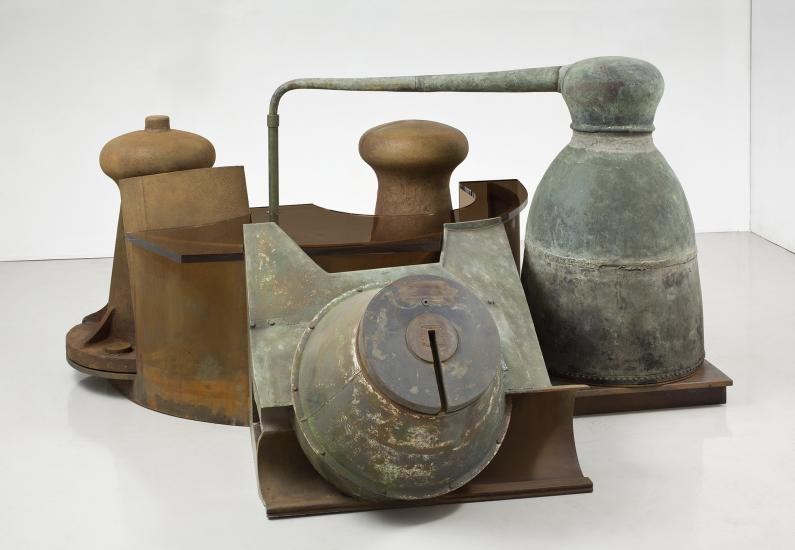Anthony Caro
11 Sep - 25 Oct 2014
ANTHONY CARO
The Last Sculptures
11 September – 25 October 2014
Often regarded as the greatest British sculptor of his generation, Anthony Caro’s long career is characterised by his innovative use of materials. Between 2011–2013 Caro began to experiment with Perspex, a material that he had only employed in one previous sculpture, the 2000 Duccio Variations No. 5. Initially interested in the transparent quality of glass, Caro turned to Perspex as a less fragile and easier material to work with. It also provided greater opportunity to experiment with colour; many of the works in the 25-strong Perspex series employ coloured sheets of Perspex, which contrast with the rusted steel or wooden structures into which they are incorporated. In End of Time (2013), for example, a shockingly bright red sheet of Perpex is placed across the top of the sculpture, while in River Run an earthy, semi-translucent green gives the metal pipes and sheets behind it an almost ghostly appearance.
Two of the works in the series play homage to Cézanne’s paintings of card players, and were inspired by a visit to an exhibition at the Courtauld Gallery in 2011. Sackbut (2011/12) and Card Game (2013) depict ‘figures’ of folded, yellow rusting steel bent over steel and Perspex tables, evoking Cézanne’s famous paintings. Also dating from 2011/12, Venetian bridges the gap between the Perspex series and the other major group of sculptures that Caro was working on at the time, the Park Avenue series. He was so pleased with the juxtaposition of steel and coloured Perspex in this work that he created another version for the Park Avenue series, which initially began as a major public commission for Park Avenue in New York.
A fully illustrated exhibition catalogue with an essay by Alastair Sooke will be available.
Coinciding with the exhibition a monograph, including essays by Michael Fried and Clement Greenberg as well as texts by Anish Kapoor, Richard Deacon and Anthony Gormley amongst others, will be published by Phaidon.
The Last Sculptures
11 September – 25 October 2014
Often regarded as the greatest British sculptor of his generation, Anthony Caro’s long career is characterised by his innovative use of materials. Between 2011–2013 Caro began to experiment with Perspex, a material that he had only employed in one previous sculpture, the 2000 Duccio Variations No. 5. Initially interested in the transparent quality of glass, Caro turned to Perspex as a less fragile and easier material to work with. It also provided greater opportunity to experiment with colour; many of the works in the 25-strong Perspex series employ coloured sheets of Perspex, which contrast with the rusted steel or wooden structures into which they are incorporated. In End of Time (2013), for example, a shockingly bright red sheet of Perpex is placed across the top of the sculpture, while in River Run an earthy, semi-translucent green gives the metal pipes and sheets behind it an almost ghostly appearance.
Two of the works in the series play homage to Cézanne’s paintings of card players, and were inspired by a visit to an exhibition at the Courtauld Gallery in 2011. Sackbut (2011/12) and Card Game (2013) depict ‘figures’ of folded, yellow rusting steel bent over steel and Perspex tables, evoking Cézanne’s famous paintings. Also dating from 2011/12, Venetian bridges the gap between the Perspex series and the other major group of sculptures that Caro was working on at the time, the Park Avenue series. He was so pleased with the juxtaposition of steel and coloured Perspex in this work that he created another version for the Park Avenue series, which initially began as a major public commission for Park Avenue in New York.
A fully illustrated exhibition catalogue with an essay by Alastair Sooke will be available.
Coinciding with the exhibition a monograph, including essays by Michael Fried and Clement Greenberg as well as texts by Anish Kapoor, Richard Deacon and Anthony Gormley amongst others, will be published by Phaidon.

